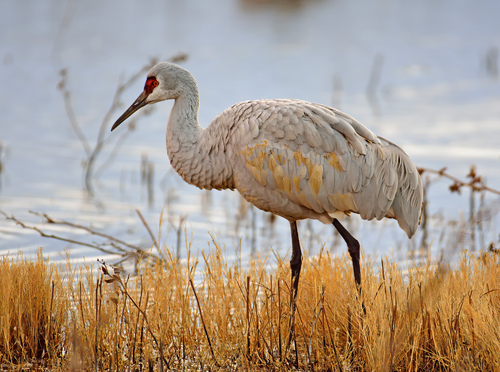
Sandhill Crane
The Sandhill Crane (Antigone canadensis) is a large, majestic bird species native to North America and extreme northeastern Siberia. Known for their striking appearance, elaborate courtship dances, and resonant calls, Sandhill Cranes play a vital role in wetland and grassland ecosystems. They are primarily herbivores, consuming seeds and grains, but also eat insects, small vertebrates, and invertebrates, contributing to the balance of their habitats. These cranes hold cultural significance for many indigenous communities, often symbolizing fidelity, longevity, and the changing seasons. Their annual migrations are a spectacular natural phenomenon, drawing birdwatchers and nature enthusiasts to key staging areas.
80-120 cm
Length
160-230 cm
Wingspan
Least Concern
Conservation Status
Distribution
Breeding range spans from Alaska and Canada, through the northern and central United States, with some populations in Cuba and extreme northeastern Siberia. Migratory populations winter in the southern United States (California, Texas, Florida) and Mexico. They exhibit a wide altitudinal range, from sea level to mountainous regions.
Lifespan
Up to 20 years or more in the wild; longer in captivity.
Sandhill Crane's Habitat
Habitat Types
Open wetlands, Marshes, Bogs, Grasslands, Agricultural fields
Climate Zones
Temperate, Subarctic, Subtropical
Adaptations
Their long legs and necks are well-suited for wading in shallow water and foraging in tall grasses. They have strong bills for probing and digging for food. Their broad wings allow for efficient soaring during migration.
Variations
Several subspecies are recognized, including the Lesser, Greater, Canadian, Mississippi, and Cuban Sandhill Cranes. These subspecies differ in size, plumage coloration, and migratory patterns. For example, the Mississippi Sandhill Crane is non-migratory and critically endangered.
Appearance
Breeding Plumage
Adults have mostly gray plumage year-round. During the breeding season, they often preen with mud containing iron oxide, giving their feathers a reddish-brown stain. This is thought to provide camouflage while nesting.
Seasonal Feather Changes
Primarily related to the preening with iron-oxide mud; otherwise, plumage remains relatively consistent.
Sex Based Plumage Differences
Minimal; males and females have similar plumage.
Notable Features
Red, bare skin patch on the crown., Long, dark, pointed bill., Long legs and neck., Bustle-like feathers over the rump.
Diet and Feeding
Primary Foods
Seeds, Grains (especially corn and wheat), Berries, Insects, Small vertebrates (e.g., rodents, frogs, snakes), Invertebrates (e.g., snails, earthworms)
Foraging Behavior
Sandhill Cranes forage by probing the ground with their bills, gleaning from the surface, and occasionally digging. They are opportunistic feeders, adapting their diet to available resources.
Specializations
Their long bill and neck allow them to reach food in a variety of substrates, from shallow water to dense vegetation.
Seasonal Diet Variations
Diet varies significantly depending on the season and location. During migration and winter, they often rely heavily on waste grains in agricultural fields. In the breeding season, they consume more insects and other invertebrates to meet the protein needs of growing chicks.
Behavior
Social Structure
Sandhill Cranes are highly social, especially during migration and winter, when they form large flocks. During the breeding season, they are territorial and defend their nesting areas.
Communication
Loud, trumpeting calls (unison calls between pairs)., Rattling calls., Purring calls (softer, close-range communication)., Visual displays (e.g., bowing, wing-flapping, head-bobbing).
Migration
Most Sandhill Crane populations are migratory, undertaking long-distance journeys between breeding and wintering grounds. They fly in large flocks, often using thermal updrafts to gain altitude and conserve energy. Key migratory routes and staging areas are crucial for their survival.
Territorial or Group Behaviors
During the breeding season, pairs establish and defend territories. Outside of the breeding season, they are highly gregarious and form large flocks for roosting and foraging.
Conservation
Threats
Habitat loss and degradation (wetland drainage, agricultural conversion)., Collisions with power lines and fences., Climate change (altering breeding and wintering habitats)., Hunting (in some areas, regulated hunting is permitted)., Disturbance at nesting sites.
Protection Programs
International Crane Foundation initiatives., Wetland restoration and conservation projects., Monitoring of populations and migration routes., Regulations on hunting and habitat protection.
Local National Laws
Protected under the Migratory Bird Treaty Act in the United States and Canada. Specific regulations vary by state and province.
Population Trend
Generally increasing, although some subspecies (e.g., Mississippi Sandhill Crane) remain endangered.
Population Estimates
Global population estimated to be over 800,000 individuals.
Interesting Facts
Sandhill Cranes are among the oldest living bird species.
Fossil evidence suggests that cranes similar to modern Sandhill Cranes existed over 2.5 million years ago.
They can fly at altitudes of up to 10,000 feet during migration.
This allows them to take advantage of favorable winds and thermal updrafts.
Their loud, trumpeting calls can be heard for miles.
These calls are used for communication within flocks and between pairs.
Sandhill Cranes mate for life.
They perform elaborate courtship dances that strengthen their pair bonds.
Faqs about Sandhill Crane
What is the difference between a Sandhill Crane and a Whooping Crane?
Whooping Cranes are larger, entirely white except for black wingtips and a red face, and are critically endangered. Sandhill Cranes are smaller, mostly gray, and have a red crown.
Where can I see Sandhill Cranes?
They can be seen in wetlands, grasslands, and agricultural fields across North America. Key migratory staging areas include the Platte River in Nebraska and Bosque del Apache National Wildlife Refuge in New Mexico.
Are Sandhill Cranes aggressive?
They can be territorial during the breeding season and may defend their nests and young. It's important to observe them from a safe distance.
Do Sandhill Cranes eat crops?
Yes, they often feed on waste grains in agricultural fields, especially during migration and winter. This can sometimes cause conflicts with farmers, but in many cases, they are gleaning leftover grain that would otherwise be wasted.
Copyright @ Nature Style Limited. All Rights Reserved.
 English
English